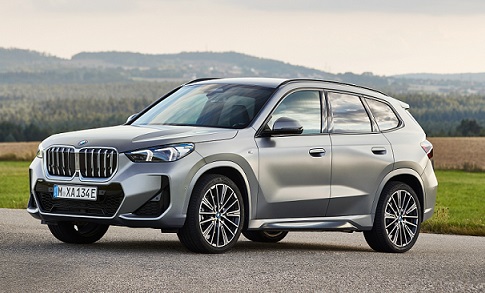Key specs
BMW iX1 (SAV) iX1 2022,2023,2024,2025,2026
What is the body type, BMW iX1 30 68 kWh (313 Hp) xDrive 2022?
SAV, 5 Doors, 5 Seats
How fast is the car, BMW iX1 30 68 kWh (313 Hp) xDrive 2022?
180 km/h, Electronically limited 111.85 mph
How many cylinders, BMW iX1 30 68 kWh (313 Hp) xDrive 2022?
Electric,
What is the drivetrain, BMW iX1 30 68 kWh (313 Hp) xDrive 2022?
All wheel drive (4x4),
How long is this vehicle, BMW iX1 30 68 kWh (313 Hp) xDrive 2022?
4500 mm
177.17 in.
How wide is the vehicle, BMW iX1 30 68 kWh (313 Hp) xDrive 2022?
1845 mm
72.64 in.
What is the curb weight, BMW iX1 30 68 kWh (313 Hp) xDrive 2022?
2010 kg
4431.29 lbs.
BMW iX1 (SAV) iX1 2022,2023,2024,2025,2026 Specs
General information
| Brand |
BMW |
| Model |
iX1 (SAV) |
| Version |
iX1 |
| Engine version |
30 68 kWh (313 Hp) xDrive |
| Year production start |
2022 |
| Vehicle type |
SAV |
| Acceleration 0 - 100 kmh sec |
5.6 sec |
| Curb weight kg -lbs total |
2010 kg
4431.29 lbs.
|
| Overall length mm - inch |
4500 mm
177.17 in.
|
| Doors |
5 |
| Top Speed |
180 km/h, Electronically limited 111.85 mph |
Engine specs
| Cylinders |
Electric |
| Weight / horsepower kg/hp - hp/tons |
6.4 kg/Hp
155.7 Hp/tonne
|
| Weight / torque kg/Nm - Nm/tons |
4.1 kg/Nm, 245.8 Nm/tonne
4.1 kg/Nm
245.8 Nm/tonne
|
| Fuel type |
Electricity |
| Powertrain architecture |
BEV (Electric Vehicle) |
| Electric motor power |
190 Hp @ 8000 rpm.
|
| Electric motor torque |
247 Nm @ 0-4900 rpm. 182.18 lb.-ft. @ 0-4900 rpm.
|
| Total available power |
313 Hp
|
| Totale available torque |
494 Nm 364.36 lb.-ft.
|
Transmission and Drive system
| Drive configuration |
All wheel drive (4x4)
|
Brakes
| Front brakes |
Ventilated discs |
| Rear brakes |
Ventilated discs |
| Anti-lock brake system |
ABS (Anti-lock braking system) |
Steering
| Steering type |
Steering rack and pinion |
| Turning diameter m - ft |
11.9 m
39.04 ft.
|
Suspension
| Front suspension |
Spring Strut |
| Rear suspension |
Independent multi-link suspension |
Wheels & Tyres
| Wheels size |
205/65 R17
|
| Wheels rims |
7.5J x 17 |
Passenger
| Passengers seats |
5 |
| Trunk space min liter | cu. Ft. |
490 l
17.3 cu. ft.
|
| Trunk space max liter | cu. Ft. |
1495 l
52.8 cu. ft.
|
| Roof load load kg lbs |
75 kg
165.35 lbs.
|
Dimensions
| Overall length mm - inch |
4500 mm
177.17 in.
|
| Overall width mm -inch |
1845 mm
72.64 in.
|
| Overall height mm -inch |
1616 mm
63.62 in.
|
| Wheelbase mm - inch |
2692 mm
105.98 in.
|
| Track width front mm - inch |
1591 mm
62.64 in.
|
| Track width rear mm - inch |
1593 mm
62.72 in.
|
| Coefficient of drag |
0.26
|
Weights
| Curb weight kg -lbs total |
2010 kg
4431.29 lbs.
|
| Gross weight kg -lbs total |
2580 kg
5687.93 lbs.
|
| Capacities kg - lbs |
570 kg
1256.63 lbs.
|
Engine type
Electric
https://www.thecarspec.com/components/engine/electric

